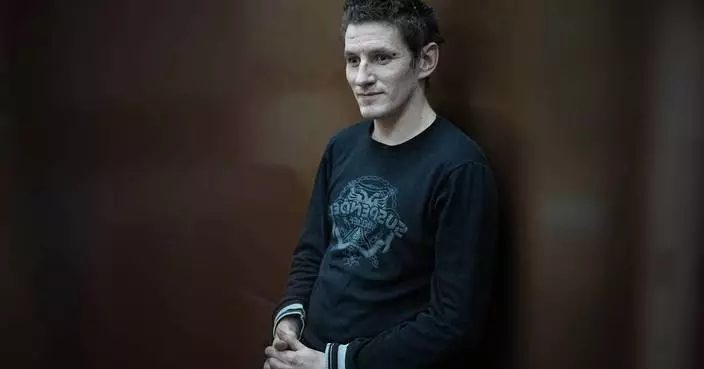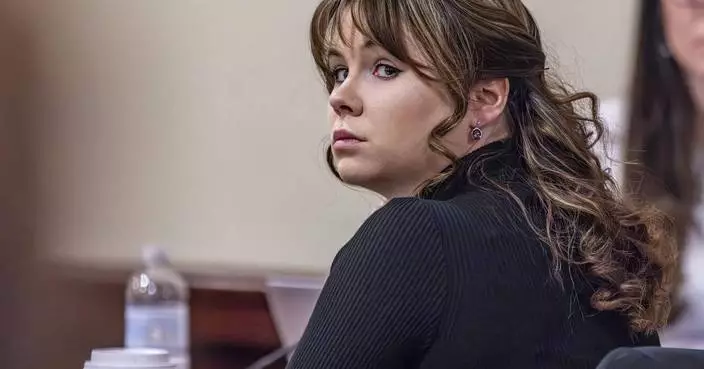Beto O'Rourke's response to a question during a Houston town hall meeting this past summer lasted only four minutes. But for some Democrats it said everything. It was authentic.
In an exchange that quickly went viral, the Democrat congressman and Senate hopeful was asked whether he found NFL players who knelt during the national anthem to be disrespectful. A passionate O'Rourke told the room of Texans, not necessarily a sympathetic crowd, that he could "think of nothing more American than to peacefully stand up, or take a knee, for your rights."
Clips of his answer were viewed millions of times online, generating buzz in O'Rourke's uphill battle against Republican Sen. Ted Cruz.
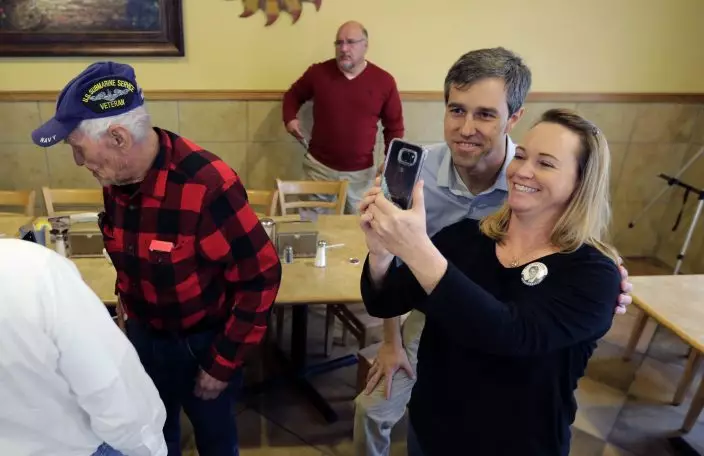
FILE - In this Sunday, Jan. 7, 2018, file photo, Texas Democratic Congressman Beto O'Rourke, second from right, poses for a photo following a town hall meeting at a restaurant in Falfurrias, Texas. For many Democrats, Beto O'Rourke's response to a question about NFL players kneeling during the national anthem was the type of moment that will be essential for a field that will challenge President Donald Trump beginning after the November elections. If there's a common buzzword in Democratic politics right now, it's "authenticity," or the desire to present candidates in an unvarnished manner that's true to themselves. (AP PhotoEric Gay, File)
For national Democrats, it was the type of moment that epitomized a common buzzword in Democratic circles — "authenticity" — and the push to present candidates in a more open, unvarnished manner offering a window to their values.
One of the widely accepted lessons from Democrat Hillary Clinton's loss in 2016 to Republican Donald Trump was that voters gravitate toward candidates they perceive as real, even if flawed. They're drawn to politicians willing to deliver unexpected candor.
"I don't think politicians give voters enough credit for the fact that people want to know who you are, what you stand for and what your values are," said Karen Finney, a Democratic strategist. "Even if they disagree with you, if they think you're coming from a principled position, they can respect that."
In an effort to deliver that authenticity this election season, the party has tried to assemble a group of candidates with nontraditional backgrounds. They've recruited veterans, women and politicians with diverse histories. They've encouraged them to talk openly about their lives in ads and to make casual, unscripted social media posts.
There's no hiding that some of this effort borrows from the man Democrats are hungry to beat.
Trump's fans often say they admired his candor and willingness to defy political conventions. Another model is Bernie Sanders' campaign against Clinton for the nomination, which was marked by the Vermont senator's unwillingness to play the part of a slick, poll-driven candidate as he railed against income inequality. Clinton was often described as too careful, rehearsed and robotic.
The push also coincides as the #MeToo movement has demanded greater accountability, and social media allows a candidate such as O'Rourke to draw thousands of Twitter views of his speeches from behind the wheel of his pickup truck.
His campaign announced a record $38.1 million raised during the past three months.
Democrats who may consider a White House run in 2020 are watching closely. They've become more accessible in the months before the formal start of that campaign.
Massachusetts Sen. Elizabeth Warren has released a decade worth of tax returns, held frequent town hall meetings and started engaging with journalists for Senate hallway interviews after shunning them in the past.
In one notable move, Warren cooperated with an exhaustive Boston Globe investigation during the summer. The paper found that the senator's career as a law professor was not helped by her assertions that she has a Native American heritage.
Other senators who are potential 2020 contenders, including Kamala Harris of California, Cory Booker of New Jersey and Amy Klobuchar of Minnesota, displayed a visceral reaction to the Supreme Court nomination of Brett Kavanaugh and tried to delay the proceedings during the then-judge's first appearance before the Senate Judiciary Committee. Harris later staged a walk out before a key vote as senators considered allegations of sexual assault made against Kavanaugh.
"We are at a point in this country where there is greater distrust of politics and political institutions than at any point in modern history," said Jesse Ferguson, a Democratic strategist and veteran of presidential and congressional campaigns. "If you can't show what you're doing and why you're doing it, nobody will believe you will actually do it."
In less contentious settings, potential candidates such as Colorado Gov. John Hickenlooper are pointing to their unusual backgrounds to vouch for their everyman appeal. Hickenlooper notes that he was laid off from his job as a geologist during the 1980s, a period that led him to open a Denver brew pub. He later became the city's mayor.
"I was out of work for almost two years and you see a different person in the mirror," Hickenlooper said at a recent Brookings Institution event alongside Gov. John Kasich, R-Ohio, as he pointed to the need for skills development.
The emphasis on authenticity has been a hallmark of a number of Democratic candidates this year who are pledging to challenge status-quo politics.
Kentucky congressional candidate Amy McGrath, for example, has drawn nearly 1.9 million views on YouTube for an ad that describes her path to becoming a combat pilot in the Marines and her pledge to protect health care.
The South Dakota's race for governor features Billie Sutton, a state senator and former rodeo star who was paralyzed from the waist down more than a decade ago after he was thrown from his horse at a North Dakota rodeo. Sutton, an underdog against Rep. Kristi Noem, a Republican backed by Trump, says the injuries were a turning point in his decision to enter public service.
VENICE. Italy (AP) — Jeffrey Gibson’s takeover of the U.S. pavilion for this year’s Venice Biennale contemporary art show is a celebration of color, pattern and craft, which is immediately evident on approaching the bright red facade decorated by a colorful clash of geometry and a foreground dominated by a riot of gigantic red podiums.
Gibson, a Mississippi Choctaw with Cherokee descent, is the first Native American to represent the United States solo at the Venice Biennale, the world’s oldest contemporary art show. For context, the last time Native American artists were included was in 1932.
Gibson, 52, accepts the weight of the honor, but he prefers to focus on how his participation can forge greater inclusion going forward.
“The first is not the most important story," Gibson told The Associated Press this week before the pavilion’s inauguration on Thursday. “The first is hopefully the beginning of many, many, many more stories to come."
The commission, his first major show in Europe, comes at a pivotal moment for Gibson. His 2023 book “An Indigenous Present" features more than 60 Indigenous artists, and he has two major new projects, a facade commission for the Metropolitan Museum of Art in New York and an exhibition at the Massachusetts Museum of Contemporary Art.
Gibson’s eye-catching exhibition titled “the space in which to place me," features text in beadwork sculptures and paintings taken from U.S. founding documents, music, sermons and proverbs to remind the viewer of the broken promises of equity through U.S. history. The vibrant use of color projects optimism. In that way, Gibson’s art is a call to action.
“What I find so beautiful about Jeffrey’s work is its ability to function as a prism, to take the traumas of the past and the questions about identity and politics and refract them in such a way that things that realities that have become flattened … can become these beautiful kaleidoscopes, which are joyous and celebratory and critical all at the same time," said Abigail Winograd, one of the exhibition’s curators.
“When I see people walk through the pavilion and kind of gasp when they walk from room to room, that’s exactly what we wanted," Winograd said.
Entering the pavilion, the beaded bodices of sculptures in human form are emblazoned with dates of U.S. legislation that promised equity, the beading cascading into colorful fringe. A painting quotes George Washington writing, “Liberty, when it begins to take root, is a plant of rapid growth," in geometric letters that meld into a colorful patterned background.
By identifying specific moments in U.S. history, Gibson said that he wants to underline that “people who are fighting for equity and justice today, we’re not the first.
“This has been a line in the history of American culture. But I’m hoping that people will think about why … some of these things … have either been revoked or have not come into fruition,” he said.
Craft is at the center of Gibson’s art, both in defiance of past denigration of craft and as a way to confront “the traumatic histories of Native American people,” he said.
“There is something very healing about the cycle of making," Gibson explained.
The pavilion’s intricate beaded sculptures owe a debt to Native American makers of the past without imitating them, employing couture techniques to create something completely new. In the way of his forbears, Gibson uses beads sourced from all over the world, including vintage beads from Japan and China, and glass beads from the Venetian island of Murano.
Paper works incorporate vintage beadwork purchased from websites, estate and garage sales in mixed media displays that honor the generations of Native American makers that preceded him.
Gibson's themes fit well into the message of inclusion of the main Biennale exhibition, titled “Stranieri Ovunque -- Strangers Everywhere,” which runs in tandem with around 90 national pavilions from April 20-Nov. 24.
His personal history has placed him firmly in what he calls the “diasporic history of Indigenous people.” His father's job took his family abroad when he was a child to Germany and then South Korea, and he later studied in Chicago and London. His partner is Norwegian artist Rune Olsen.
Through all of this, Gibson has picked up traditions and practices that go beyond his Indigenous background.
“I’ve looked at op art, pattern and decoration. I've looked at psychedelia, I have taken part in rave culture and queer culture and drag and the whole spectrum," Gibson said.
"And so for me, I would not be telling you the whole truth if I only chose to spoke about indigeneity. But my body is an Indigenous body — it’s all funneled through this body,'' he said. ”And so my hope is that by telling my experience, that everyone else can project their own kind of intersected, layered experience into the world.”
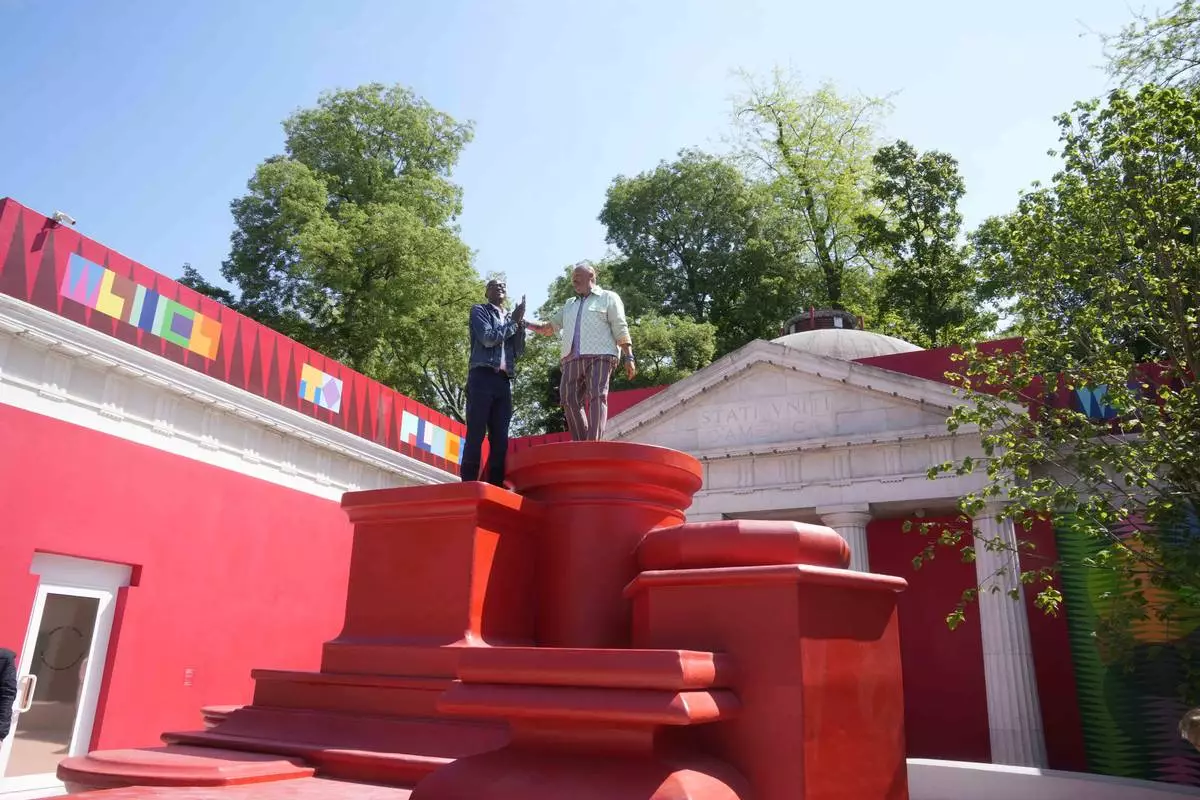
Artist Jeffrey Gibson, right, poses with artist Mark Bradford at the U.S. pavilion during the media open day at the 60th Biennale of Arts in Venice, Italy, Tuesday, April 16, 2024. A Mississippi Choctaw of Cherokee descent, Gibson is the first Native American to represent the United States solo at the Venice Biennale, the world’s oldest contemporary art show. Gibson mixes Western modernism and Native American craft in his vibrantly hued paintings and sculptures. (AP Photo/Luca Bruno)
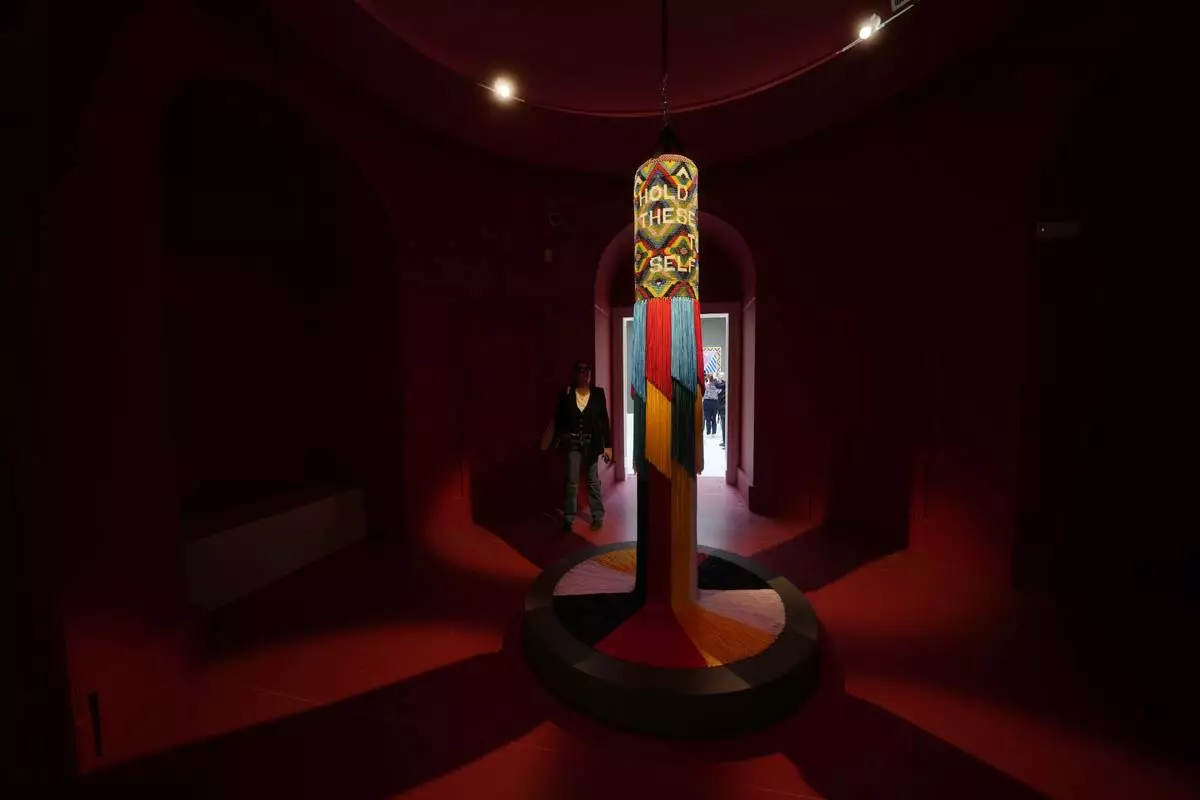
Visitors look at sculptures on display inside the US pavilion by artist Jeffrey Gibson during the 60th Biennale of Arts in Venice, Italy, Tuesday, April 16, 2024. A Mississippi Choctaw of Cherokee descent, Gibson is the first Native American to represent the United States solo at the Venice Biennale, the world’s oldest contemporary art show. Gibson mixes Western modernism and Native American craft in his vibrantly hued paintings and sculptures. (AP Photo/Luca Bruno)
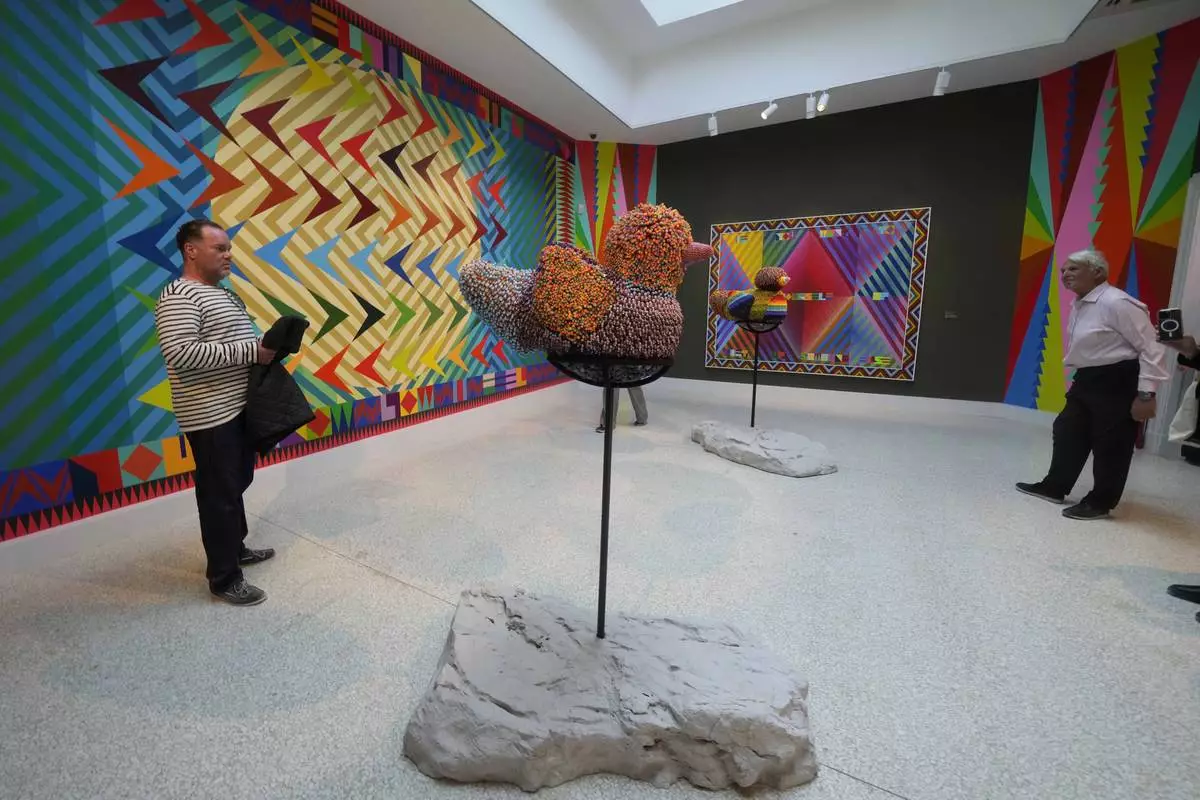
Visitors look at sculptures on display inside the US pavilion by artist Jeffrey Gibson during the 60th Biennale of Arts in Venice, Italy, Tuesday, April 16, 2024. A Mississippi Choctaw of Cherokee descent, Gibson is the first Native American to represent the United States solo at the Venice Biennale, the world’s oldest contemporary art show. Gibson mixes Western modernism and Native American craft in his vibrantly hued paintings and sculptures. (AP Photo/Luca Bruno)

Visitors look at sculptures on display inside the US pavilion by artist Jeffrey Gibson during the 60th Biennale of Arts in Venice, Italy, Tuesday, April 16, 2024. A Mississippi Choctaw of Cherokee descent, Gibson is the first Native American to represent the United States solo at the Venice Biennale, the world’s oldest contemporary art show. Gibson mixes Western modernism and Native American craft in his vibrantly hued paintings and sculptures. (AP Photo/Luca Bruno)

Visitors look at sculptures on display inside the US pavilion by artist Jeffrey Gibson during the 60th Biennale of Arts in Venice, Italy, Tuesday, April 16, 2024. A Mississippi Choctaw of Cherokee descent, Gibson is the first Native American to represent the United States solo at the Venice Biennale, the world’s oldest contemporary art show. Gibson mixes Western modernism and Native American craft in his vibrantly hued paintings and sculptures. (AP Photo/Luca Bruno)
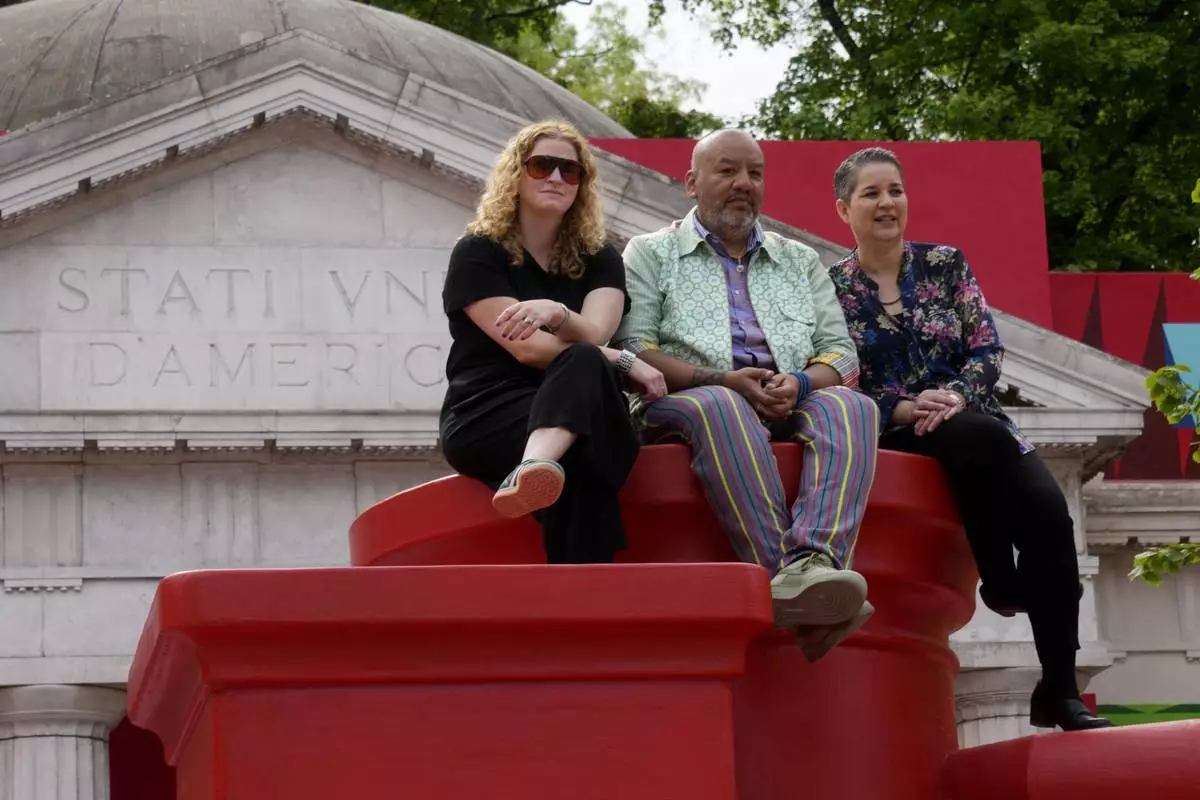
From left, Curator Abigail Winograd, artist Jeffrey Gibson, and Curator Kathleen Ash-Milby pose at the US pavilion during the media open day at the 60th Biennale of Arts in Venice, Italy, Tuesday, April 16, 2024. A Mississippi Choctaw of Cherokee descent, Gibson is the first Native American to represent the United States solo at the Venice Biennale, the world’s oldest contemporary art show. Gibson mixes Western modernism and Native American craft in his vibrantly hued paintings and sculptures. (AP Photo/Luca Bruno)
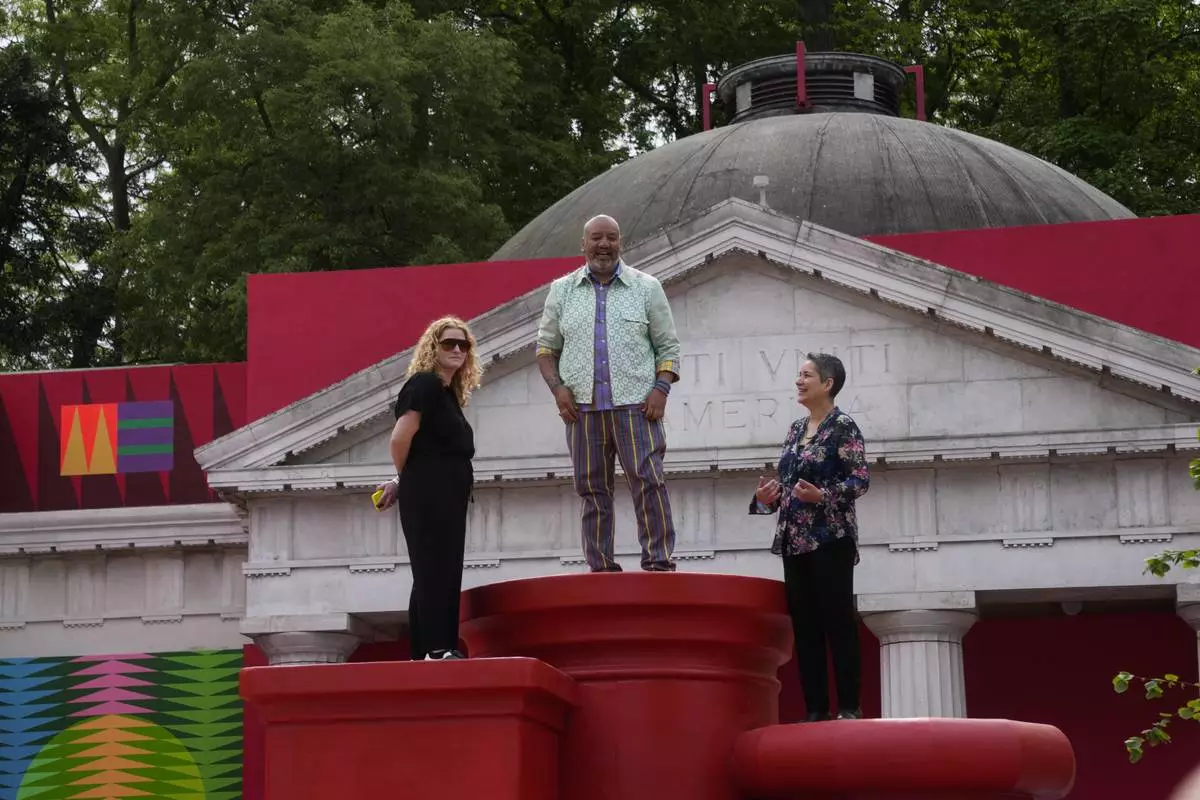
From left, Curator Abigail Winograd, artist Jeffrey Gibson, and Curator Kathleen Ash-Milby pose at the US pavilion during the media open day at the 60th Biennale of Arts in Venice, Italy, Tuesday, April 16, 2024. A Mississippi Choctaw of Cherokee descent, Gibson is the first Native American to represent the United States solo at the Venice Biennale, the world’s oldest contemporary art show. Gibson mixes Western modernism and Native American craft in his vibrantly hued paintings and sculptures. (AP Photo/Luca Bruno)
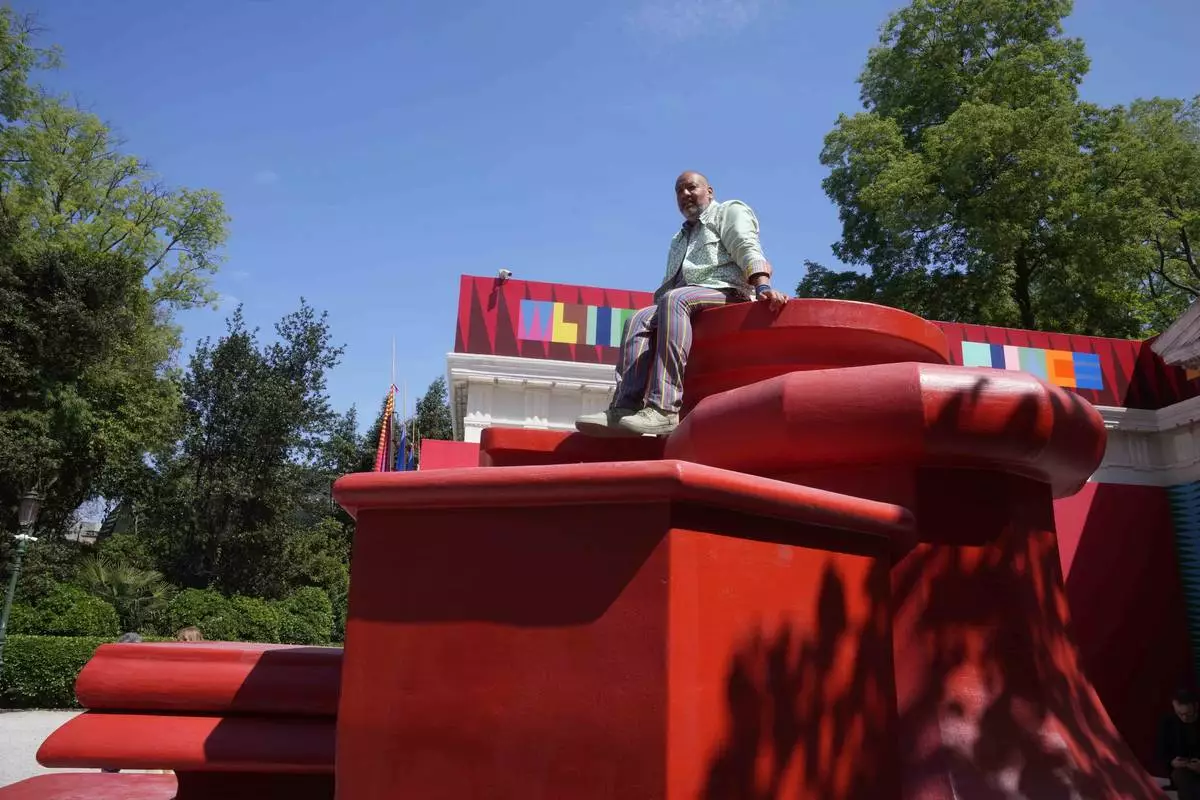
Artist Jeffrey Gibson poses at the US pavilion during a media open day at the 60th Biennale of Arts in Venice, Italy, Tuesday, April 16, 2024. A Mississippi Choctaw of Cherokee descent, Gibson is the first Native American to represent the United States solo at the Venice Biennale, the world’s oldest contemporary art show. Gibson mixes Western modernism and Native American craft in his vibrantly hued paintings and sculptures. (AP Photo/Luca Bruno)
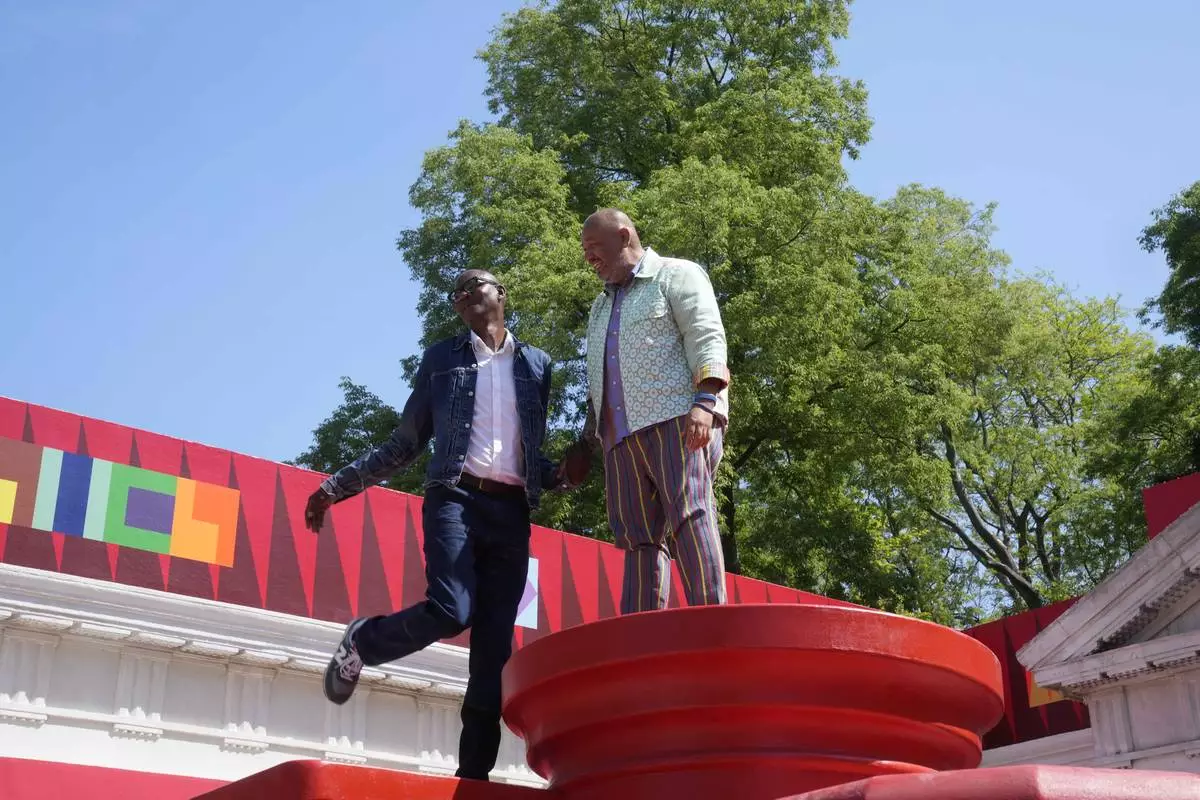
Artist Jeffrey Gibson, right, poses with artist Mark Bradford at the U.S. pavilion during the media open day at the 60th Biennale of Arts in Venice, Italy, Tuesday, April 16, 2024. A Mississippi Choctaw of Cherokee descent, Gibson is the first Native American to represent the United States solo at the Venice Biennale, the world’s oldest contemporary art show. Gibson mixes Western modernism and Native American craft in his vibrantly hued paintings and sculptures. (AP Photo/Luca Bruno)
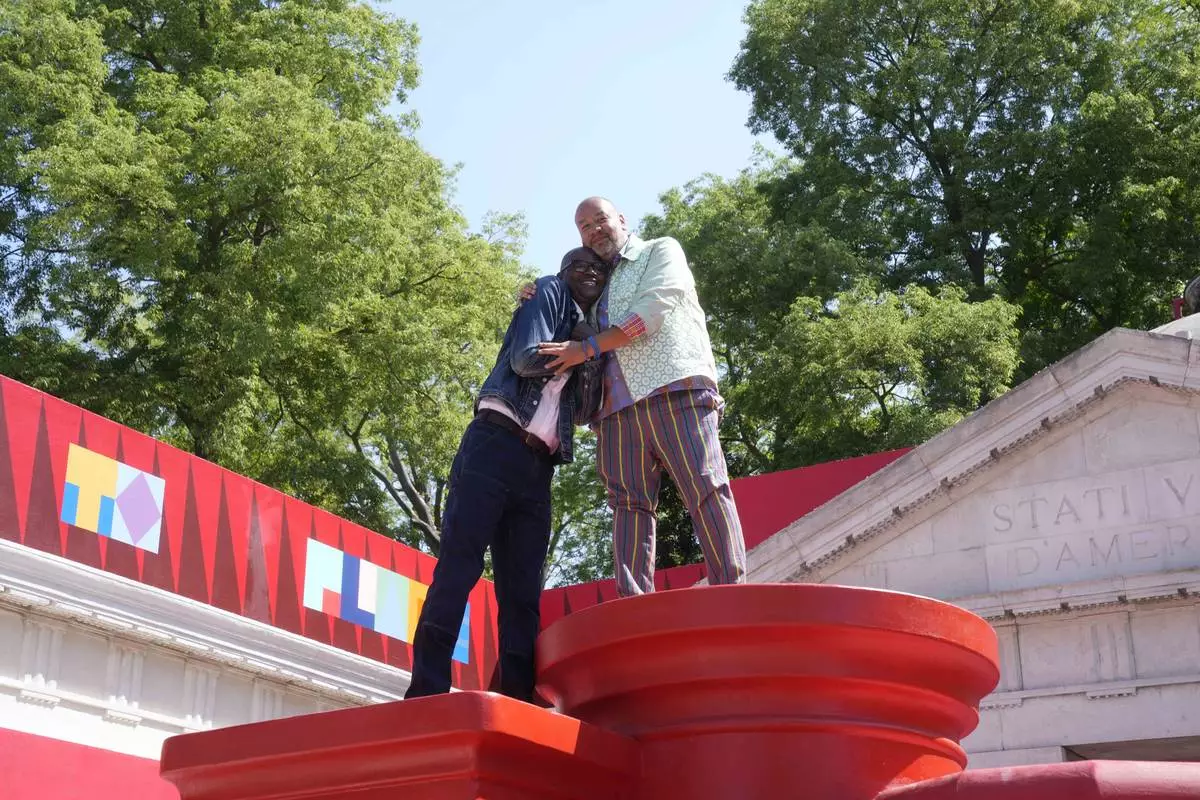
Artist Jeffrey Gibson, right, hugs artist Mark Bradford at the U.S. pavilion during media open day of the 60th Biennale of Arts exhibition in Venice, Italy, Tuesday, April 16, 2024. A Mississippi Choctaw of Cherokee descent, Gibson is the first Native American to represent the United States solo at the Venice Biennale, the world’s oldest contemporary art show. Gibson mixes Western modernism and Native American craft in his vibrantly hued paintings and sculptures. (AP Photo/Luca Bruno)
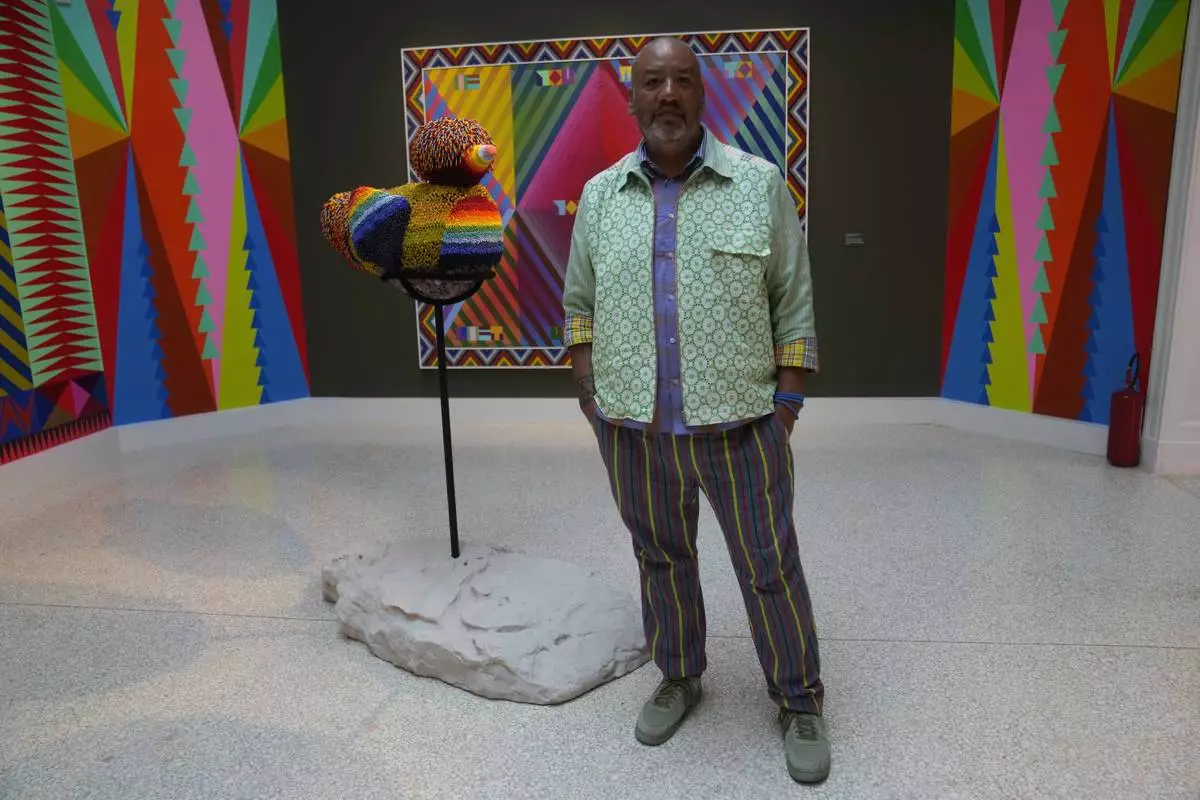
Artist Jeffrey Gibson poses inside the US pavilion during the media open day at the 60th Biennale of Arts in Venice, Italy, Tuesday, April 16, 2024. A Mississippi Choctaw of Cherokee descent, Gibson is the first Native American to represent the United States solo at the Venice Biennale, the world’s oldest contemporary art show. Gibson mixes Western modernism and Native American craft in his vibrantly hued paintings and sculptures. (AP Photo/Luca Bruno)




















